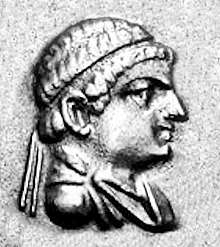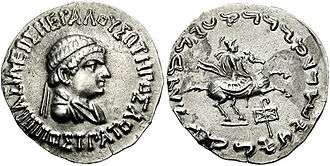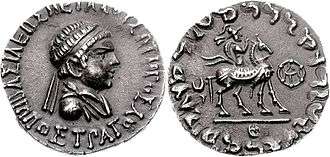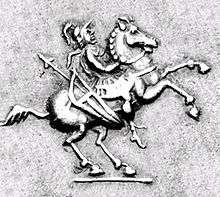Hippostratos
Hippostratos (Greek: Ἱππόστρατος) was an Indo-Greek king who ruled central and north-western Punjab and Pushkalavati. Bopearachchi dates Hippostratos to 65 to 55 BCE whereas R. C. Senior suggests 60 to 50 BCE.
| Hippostratos | |
|---|---|
 Hippostratos portrait. | |
| Indo-Greek king | |
| Reign | 65–55 BCE |

Obv: Bust of Hippostratos with Greek legend ΒΑΣΙΛΕΩΣ ΜΕΓΑΛΟΥ ΣΩΤΗΡΟΣ ΙΠΠΟΣΤΡΑΤΟΥ "Of Great Saviour King Hippostratos".
Rev: King on horseback, galloping. Kharoshthi legend: MAHARAJASA TRATASA MAHATASA JAYAMTASA HIPUSTRATASA "King Hippostratos, the Great Saviour and Conqueror.

Obv: Bust of Hippostratos with Greek legend BΑΣΙΛΕΩΣ ΜΕΓΑΛΟΥ ΣΩΤΗΡΟΣ ΙΠΠΟΣΤΡΑΤΟΥ "Great Saviour King/ Hippostratos".
Rev: King on horseback, walking, making a gesture of benediction. Kharoshthi legend: MAHARAJASA TRATASA MAHATASA JAYAMTASA HIPUSTRATASA "King Hippostratos, the Great Saviour and Conqueror.
Rule
In Bopearachchi's reconstruction Hippostratos came to power as the successor to Apollodotus II, in the western part of his kingdom, while the weak Dionysios ascended to the throne in the eastern part. Senior assumes that the reigns of Apollodotus II and Hippostratos overlapped somewhat; in that case Hippostratos first ruled a kingdom situated to the west of Apollodotus' dominions.

Just like Apollodotus II, Hippostratos calls himself Soter, "Saviour", on all his coins, and on some coins he also assumes the title Basileos Megas, "Great King", which he inherited from Apollodotus II. This may support Senior's scenario that Hippostratos extended his kingdom after Apollodotus' death. The relationship between these two kings remains uncertain due to lack of sources. Hippostratos did not, however, use the symbol of standing Athena Alkidemos, which was common to all other kings thought to be related to Apollodotus II. The two kings share only one monogram.
The quantity and quality of the coinage of Hippostratos indicate a quite powerful king. Hippostratos seems to have fought rather successfully against the Indo-Scythian invaders, led by the Scythian king Azes I, but was ultimately defeated and became the last western Indo-Greek king.
Coins of Hippostratos
Hippostratos issued silver coins with a diademed portrait on the obverse, and three reverses. The first is the image of a king on prancing horse, a common type which was most frequently used by the earlier kings Antimachus II and Philoxenus. The second reverse also portrays a king on horseback, but the horse is walking and the king making a benediction gesture - this type resembles a rare type of Apollodotus II. The third is a standing goddess, perhaps Tyche.
Hippostratos struck several bronzes of types used by several kings: Serpent-legged deity (as used by Telephus) / standing goddess. Apollo/tripod (Apollodotus II, several earlier kings) Sitting Zeus-Mithras / horse, reminiscent of coins of Hermaeus.
Overstrikes
Azes I overstruck several of Hippostratos' coins.
References
- The Greeks in Bactria and India, W.W. Tarn, Cambridge University Press
External links
| Preceded by Apollodotus II |
Indo-Greek Ruler (in Western Punjab) 65 – 55 BCE |
Succeeded by Azes I (as Indo-Scythian King) |
- O. Bopearachchi, "Monnaies gréco-bactriennes et indo-grecques, Catalogue raisonné", Bibliothèque Nationale, Paris, 1991, p.453
- Quintanilla, Sonya Rhie (2 April 2019). "History of Early Stone Sculpture at Mathura: Ca. 150 BCE - 100 CE". BRILL – via Google Books.



